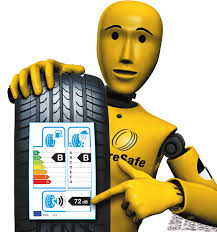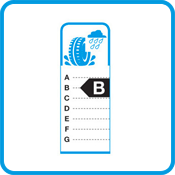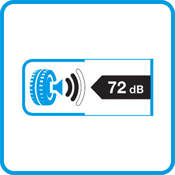Tyre Labelling
THE NEW WAY TO COMPARE TYRES
 Tyre Labels were introduced by the EU and are designed to make tyre comparison simple. There are three key measures for each and every tyre for sale throughout Europe; Fuel Efficiency, Performance in the wet (braking distances) and Road Noise. Once you know what to look for you will quickly understand what each label means.
Tyre Labels were introduced by the EU and are designed to make tyre comparison simple. There are three key measures for each and every tyre for sale throughout Europe; Fuel Efficiency, Performance in the wet (braking distances) and Road Noise. Once you know what to look for you will quickly understand what each label means.
In fact we offer you a chance to filter for tyres that give you the best braking performance, the best fuel efficiency or the lowest road noise when you look through our range.
Fuel Efficiency.
 Tyres that are rated “A” will give you a much more efficient drive than those rated “G”. It is a wise choice to choose a tyre that is more fuel efficient. It is not only a massive benefit to you, by saving you money and taking more time between trips to the pump, but it also has a more positive environmental effect than lower rated tyres.
Tyres that are rated “A” will give you a much more efficient drive than those rated “G”. It is a wise choice to choose a tyre that is more fuel efficient. It is not only a massive benefit to you, by saving you money and taking more time between trips to the pump, but it also has a more positive environmental effect than lower rated tyres.
A car fitted with four A-rated tyres will save a massive 80 litres of fuel over the life of the tyres, which is the equivalent of over a whole tank of petrol saved and roughly £110 with today’s prices. Driving at 50mph, A-rated tyres will use around 7.5% less fuel than if your tyres were G-rated.
Wet Performance.
 How your tyres perform on wet roads is extremely important. They are the only thing keeping you glued to the road, and with the risk of aquaplaning during very bad weather, choosing a tyre that has a higher wet performance rating than others could potentially be life-saving.
How your tyres perform on wet roads is extremely important. They are the only thing keeping you glued to the road, and with the risk of aquaplaning during very bad weather, choosing a tyre that has a higher wet performance rating than others could potentially be life-saving.
Again, you can review how well a tyre has been classified with the A-G rating, with A-rated tyres having a much shorter stopping distance, and therefore being much safer, than G-rated tyres.
If you have a car with four A-rated tyres, you will stop up to four car lengths shorter than G-rated tyres, which can prevent crashes and potentially save lives. At 50mph you will have a decreased stopping distance of up to 18m, which is up to 30% better than more poorly rated tyres.
Road Noise.
 This diagram is different to the A-G rated symbols of the fuel efficiency and wet grip. Tyres are rated on a scale of three noise waves, as well as a decibel level of what the maximum noise level recorded for that tyre is. In the future, regulations will be put in place to set a maximum road noise level from tyres.
This diagram is different to the A-G rated symbols of the fuel efficiency and wet grip. Tyres are rated on a scale of three noise waves, as well as a decibel level of what the maximum noise level recorded for that tyre is. In the future, regulations will be put in place to set a maximum road noise level from tyres.
If a tyre has three black waves then it is one of the noisier tyres. It means that the level of noise that it emits is actually greater than what the future regulation will be, but it is still legal by today’s standards.
Two waves mean that a tyre performs at an average level and the noise emitted is equal to, or three decibels lower than, the future regulations.
A single wave indicates a very low noise from the tyre. You will get a minimum of three decibels lower than the future noise limit – and even lower in some cases. Three decibels might not sound like a lot of difference, but you will certainly realise the change when you start driving.
Don’t forget, the noise that you hear inside the car isn’t always relative to the noise being emitted by your tyres on the outside.


Leave a Reply